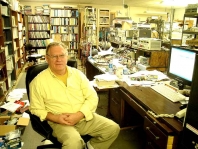About

Electronic Design & Research Inc. is a small high-tech company that develops and manufactures high-performance solid-state modules, such as relays/switches, high-speed push-pull drivers, several families of H-drivers, highly efficient Charge-and-Add DC/DC converters, high-current switching systems capable of delivering megawatts of power in 50 ns, power distribution switches for power back-up systems. For biomedical applications, we offer a super-high resolution EKG for recording the His Bundle signal from a body surface on beat-by-beat basis, high-speed biases generator (DDS-701, HSBG-602, etc.) for MRI/MRS, etc. EDR's innovative solutions serve high-growth applications within the automotive market, thermo-electrical coolers/heaters, with additional focus on aviation, and industrial solutions, and various research facilities. Further information about EDR Inc. can be found at http://www.vsholding.com
Contacts:
Vladimir A Shvartsman, Ph.D. Tel: (502) 933-8660 V_Shvartsman@vsholding.com
- Status
- Private Company
- Founded
- 1984
- # Employees
- 12
- Industries
-
- Computer & Electronic Product Manufacturing
- Computer & Peripheral Equipment Manufacturing
- Computer Terminal Manufacturing
- Electrical Equipment Manufacturing
- Electrical Equipment, Appliance, & Component Manufacturing
- Electromedical & Electrotherapeutic Apparatus Manufacturing
- Electronics
- Manufacturing
- Navigational, Measuring, Electromedical, & Control Instruments Manufacturing
- Relay & Industrial Control Manufacturing More
Company History
Encouraged by successful implementation of the neural-cell (NeuTAC) signal-processing principals described in US Patent 4,692,709 into a Super-High Resolution EKG recorder capable of detecting the Bundle His signal from the body surface on a bit-by-bit basis. That and my other research investigations were published about 110 times in various publications. The Super-High Resolution EKG is capable of a multichannel NeuTAC to detect a faint signal (-32 db of SNR) which is completely buried in random noise. This could help gain easy acceptance. Working in the Department of Cardiology at the University of Louisville (U of L), under NIH grants, was a major impediment with developing applications for the neural-cell based technology. In 1983, I created Electronic Design & Research for expanding that technological marvel into the medical industry and into other fields of science that need advance signal-processing capabilities.
Life is a chain of mistakes. One of my biggest mistakes was remaining in Kentucky, where horses, tobacco and tourism have been the government’s major priorities. I should've immediately moved into a more technologically inclined state. Hiring a crooked lawyer for raising a working capital made the matters worse. During the following eight months, he was able to embezzle all moneys that were raised. Later, I was awarded with three SBIRs (Phase I) grants, which did not help me to grow the company much. Only Phases II and III provided enough money for a product’s commercialization. Kentucky’s government refused to help with solicitation because, as they explained, technologies weren’t their priorities. I published several books describing my art (painting) and difficulty with operating a high-tech company in Kentucky.

